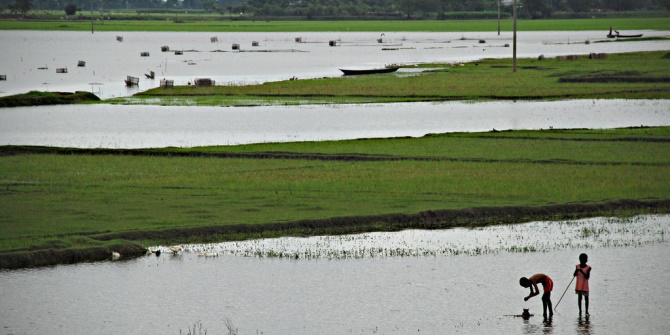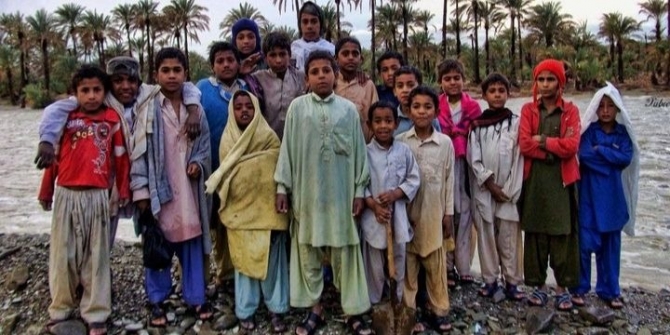
 On Monday, the twenty-first session of the Conference of the Parties (COP 21) begins in Paris. Mubashar Hasan and Khurshed Alam highlight the importance of the conference for Bangladesh as the country that is most vulnerable to climate change. They write that the effects are already being felt leading to vast numbers of poor and marginalised internal migrants flooding the cities or attempting to emigrate, with major policy implications at local, regional and global levels.
On Monday, the twenty-first session of the Conference of the Parties (COP 21) begins in Paris. Mubashar Hasan and Khurshed Alam highlight the importance of the conference for Bangladesh as the country that is most vulnerable to climate change. They write that the effects are already being felt leading to vast numbers of poor and marginalised internal migrants flooding the cities or attempting to emigrate, with major policy implications at local, regional and global levels.
Governments are scheduled to meet in Paris next week to discuss climate change at the 2015 United Nations Climate Change Conference as part of the United Nations Framework Convention on Climate Change (UNFCCC). At the summit, it is vital for negotiating governments to reach a legally blinding agreement in order to curb greenhouse gas emission to an acceptable rate to protect poor countries like Bangladesh, which is rated as the country which is most vulnerable to changing climate by a global risk advisory firm Maplecroft due to Bangladesh’s extreme levels of poverty and a high dependency on agriculture.
According to the Centre for Environmental and Geographic Information Services (CEGIS) based in Bangladesh, around 160 thousand hectares of farmland were lost between 1973 and 2009 due to erosion in the Ganges, Jamuna and Padma rivers. It is projected that the erosion could increase as much as 60% in the left bank of Jamuna river and around 20% in Ganges and Padma rivers by 2100. Between 2005-50 agricultural GDP in Bangladesh is projected to drop 3.1 per cent each year as a result of climate change. In addition, Bangladesh is at high risk of drought and flooding. This is illustrated during October 2010, when 500,000 people were driven from their homes by flood waters created by storms.

Globally, it is well-recognised that despite being a low contributor to global green house gas emissions, Bangladesh—which sits in the largest delta in the world – is experiencing serious natural and socio-economic disruptions triggered by climate change. Less discussed is the fact that the on-going multidimensional environmental and socio-economic disruption is premised upon displacement and migration, where hundreds and thousands of poor people who would ordinarily remain in rural areas and make their living from the land are moving into the cities. A 2012 study predicted that between three and 10 million Bangladeshis would be forced to relocate over the next 40 years because of climate change. The most popular destination for these internal migrants is Dhaka—the capital city where according to a World Bank estimate about 300,000 people migrate each year.
A recent qualitative study conducted by the Bangladesh Institute of Social Research Trust (BISRT) aimed to understand factors behind urban migration found that river erosion, sea level rise, drought, rising salinity, and extreme weather related events are key drivers of mass urban migration in Bangladesh. The study further explored the human impact of climate migration in two fronts: (a) changing lives of climate migrants and (b) the likely impact of climate migration on Bangladeshi society.
In order to address the human impact questions, BISRT interviewed climate migrants, civil society members and members of government negotiation team who are to participate in the upcoming Paris summit. In our initial assessment we found that climate induced migration in Bangladesh has three major policy implications which are local, regional and global in nature.
Firstly, climate change in Bangladesh is set to weaken the capacity of the state against the backdrop of the rising vulnerability among the climate migrants who are adding extra pressures upon cities, which already have limited resources. Some of the climate migrants we interviewed were found to be struggling to adapt to the city having lost their savings and traditional sources of income. One of our interviewees, know simply as Alam, who lives in a slum named Bhola, in Dhaka city said:
“I used to employ about three people in my local business. However, after the river washed my home and farmlands away, I had to move here in Dhaka with my family in 2013. All my savings were gone with my home since I invested a large amount of money in a fishing boat which too was unfortunately drowned in the deep sea against the backdrop of a sudden cyclone.”
Alam now pulls rickshaws in Dhaka city. He continued:
“this type of job is not good as socially rickshaw-pullers are looked down in Bangladesh and I hardly could make any money…I never pulled rickshaw before, some times I am fearful of my life as roads in Dhaka city are dangerous but then again I think what is the point of living like this with no or little money.”
Alam is the latest addition into the growing number of slum dwellers in the country. In the past 17 years, numbers have increased by 60.43 percent. That means presently about 2.23 million Bangladeshis live in slums, without access to civic amenities.
Faruk Islam, a day labourer who moved into a Dhaka slum from Bhola District after his home was washed away, commented “sometimes I feel that I am reduced to an animal who just survive for food”. Faruk said he has no entertainment in his life as he works over 12 hours a day.
The evolving social dynamics are not encouraging. In Bangladesh 51.3% of the total population of about 160 million live in poverty according to the 2015 Oxford Poverty and Human Development Initiative (OPHD). Simultaneously economic disparity between rich and poor is increasing and per capita income is unevenly distributed. Previous research of the BISRT indicates that in addition to resorting to internal migration, many poor and marginalised Bangladeshis are found to be boarding rickety boats to neighbouring countries in the hope of escaping poverty linked with the climate change.
Professor Ali Riaz has written that against the backdrop of so many poor who have little or no stake in the system struggling to make a stable living, the state’s legitimacy is being eroded. Non-state actors have stepped into deliver certain socio-economic services since the absence of state agencies creates an opportunity for the growth of parallel authority. “The rise of vigilante groups, particularly Islamist militants, in parts of the northwestern and western regions, testifies to this fact,” according to Riaz. Riaz’s assessment fits with the observation of Maplecroft, which argues “Bangladeshi government has the lowest capacity of all countries to adapt to predicted changes in the climate.”
Bangladesh’s evolving situation is worth comparing to an interesting theory coined by Michael T Klare who argued that climate induced migration played a big part in shaping current conflict in Syria. He observed that between 2006-2010 Syria has experienced a devastating drought in which climate change is believed to have been a factor, turning nearly 60 percent of the country into desert. Against this backdrop, according to Klare “thousands of Syrian farmers have moved into the major cities for new livelihoods but faced hostility from well-connected urban elites”. Klare concludes “had Bashar al Assad responded with an emergency housing and job for climate migrants perhaps the ongoing high-profile conflict in Syria may be averted”.
In our view, while Klare ignores wider geopolitical interest in shaping Syrian conflict, he offers a convincing pattern of linking climate change and unrest, which may or may not be relevant for the future of Bangladesh. For example, the ongoing marches of Bangladeshi climate migrants have met with the growing authoritarian tendency of the state, unequal distribution of wealth, rise of youth unemployment and challenges posed by Islamists. This is an explosive context for unrest. However, the hope is that Bangladesh’s current Prime Minister Sheikh Hasina is found to be committed to fight the multi dimensional battle imposed by climate change as a recognition of which the UN Environmental Programme recently awarded her with the “Champion of the Earth” title. Her archrival Khaleda Zia of Bangladesh Nationalist Party too iss sympathetic to climate change. Nevertheless, the Bangladeshi state remains weak and poor.
Secondly, climate migration has regional implications. As has been mentioned, our previous study found climate migrants taking boats to cross seas. In doing so, they are most likely to meet one of these four fates: (a) ending up as an illegal migrant in East Asian countries, Europe or Australia (there are reports in local media that many Bangladeshis join up with Syrian refugees and enter via the same routes) (b) landing in East Asian jails (c) being held as a captive by human traffickers or (d) death. Just as the migrant crisis in Europe is a product of internal chaos in Syria and Iraq, Bangladesh’s internal problems have wider implications for its neighbours.
India in particular is already facing challenges due to illegal migration of Bangladeshis, on top of the threats that climate change poses directly to the South Asian giant. Riaz quoted an UNFCCC document which states: “Population growth and land scarcity has encouraged the migration of more than 10 million Bangladesh natives to neighboring Indian states during the past two decades. This migration has been exacerbated by a series of floods and droughts affecting the livelihoods of landless and poor farmers in this region.” It should be noted that about 70% of India’s 2,544-mile border with Bangladesh is covered by eight-feet tall barbed wire fence and India recently has undertaken a mega project to expand it to tackle ongoing emigration problem from Bangladesh.
Finally, it is understood from Bangladeshi policymakers that they would want the world to reach a legally binding agreement in Paris this year. At the same time Bangladesh wants its development partners to increase more funds for adaptation purpose. ‘Currently only 25 precent of Bangladesh’s adaptation budget comes from abroad and it is discouraging given the fact that most of Bangladesh’s development partners are majorly guilty for causing climate change’ said a top bureaucrat who is to be a member of Bangladeshi representatives in Paris and wished to remain anonymous.
About the Authors
 Mubashar Hasan is a research fellow of Bangladesh Institute of Social Research Trust and a PhD Candidate at the School of Government and International Relations, Griffith University, Australia. He is also an adjunct faculty at the Department of Media Studies and Journalism, University of Liberal Arts Bangladesh. He is the founder of alochonaa.com, a politics, culture and IR blog, and tweets @mubashardhaka.
Mubashar Hasan is a research fellow of Bangladesh Institute of Social Research Trust and a PhD Candidate at the School of Government and International Relations, Griffith University, Australia. He is also an adjunct faculty at the Department of Media Studies and Journalism, University of Liberal Arts Bangladesh. He is the founder of alochonaa.com, a politics, culture and IR blog, and tweets @mubashardhaka.
 Dr Khurshed Alam is the Chairman of the Bangladesh Institute of Social Research (BISR) Trust. He worked over for over 29 years as a senior consultant in many government departments, ADB and World Bank. He previously was a university teacher and was involved in preparing the government’s national plan for the country Bangladesh in 2008.
Dr Khurshed Alam is the Chairman of the Bangladesh Institute of Social Research (BISR) Trust. He worked over for over 29 years as a senior consultant in many government departments, ADB and World Bank. He previously was a university teacher and was involved in preparing the government’s national plan for the country Bangladesh in 2008.







